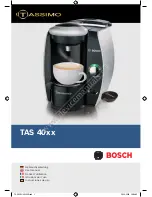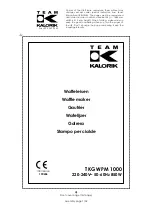
10
Operation
CUTTING GROUP
The cutting group is chosen on the basis of the length of the pasta to be cut.
LONG-TYPE PASTA
Use group 1 with knife with alternative movement. Release the fixed handwheel (Fig.10 A) and wheel the
group (Fig.10 B) until reaching the edge of the guide slit, the knife (Fig.10 C) must be at about the same height
as the drawplate axle). Block the handwheel in the new position.
NOTE: Make sure that group 2 (Fig.10 D) which controls the rotating knife is in the stop position.
WARNING: The group position is signalled by a safety microswitch which prevents the functioning of
the knife, if the group is not inserted in its correct functioning position.
Position the selector (Fig.11 A) on position 1 and regulate the potentiometer (Fig.11 B) to the number desired,
bearing in mind that the numbers indicate the interval shown in seconds x 2, which pass between one cut and
another.
SHORT-TYPE PASTA
Use group 2 (Fig.12 A) with rotating knife. Make sure that the control group 1 (Fig.12 B) is not in the functioning
position, in order to avoid interference between the two groups. Prepare the group, by simply mounting the
knife (Fig.12 C) on the control shaft (the knife must not be blocked in the shaft) while it is in the stop position.
Position the cutting group (Fig.12 A) after having released the handwheel (Fig.13 A) in front of the drawplate
(Fig.12 D), paying attention that the knife (Fig.12 C) moves axially towards the motor and adheres well to the
drawplate (Fig.12 D). To complete this operation, facilitate the movement of the knife by helping yourself, with
your hands, closing the knife tang between two fingers (Fig.12).
NOTE: This group is also controlled by a micro-switch that does not allow the knife to function in a
different position from the one illustrated above.
NOTE: Remember to position the cutting group protection correctly.
Block the handwheel (Fig.13 A) and the selector on position 2 (Fig.11 A) and regulate the knife speed
according to the desired pasta length, by turning the speed-control knob (Fig.11 D). The speed increases
steadily from 0 to maximum, the numbers go from 0 to 10. If the product is quite wet and tends to be sticky, it is
best to dry the surface in any case, by switching on the fan (Fig.14 A).
COOLING SYSTEM OF THE EXTRUSION SLEEVE
The machine is equipped with a cooling device of the extrusion sleeve that can be on, while bearing in mind
some functioning parameters: Mixture consistency and room temperature. Open the regulating tap before
beginning this operation.
NOTE: If the product is kneaded at an excessive temperature, it tends to change colour and/or blanch
slightly.
Summary of Contents for PM-IT-0080
Page 15: ...15 Figure Drawings...
Page 16: ...16 Figure Drawings...
Page 17: ...17 Figure Drawings...
Page 18: ...18 Figure Drawings...
Page 19: ...19 Figure Drawings...
Page 20: ...20 Figure Drawings...
Page 21: ...21 Figure Drawings...
Page 22: ...22 Parts Breakdown Model PM IT 0080 13286...
Page 23: ...23 Parts Breakdown Model PM IT 0080 13286...
Page 24: ...24 Parts Breakdown Model PM IT 0080 13286...
Page 26: ...26 Electrical Schematics Model PM IT 0080 13286...
Page 27: ...27 Electrical Schematics Model PM IT 0080 13286...
Page 28: ...28 Electrical Schematics Model PM IT 0080 13286...
Page 29: ...29 Electrical Schematics Model PM IT 0080 13286...
Page 30: ...30 Electrical Schematics Model PM IT 0080 13286...











































